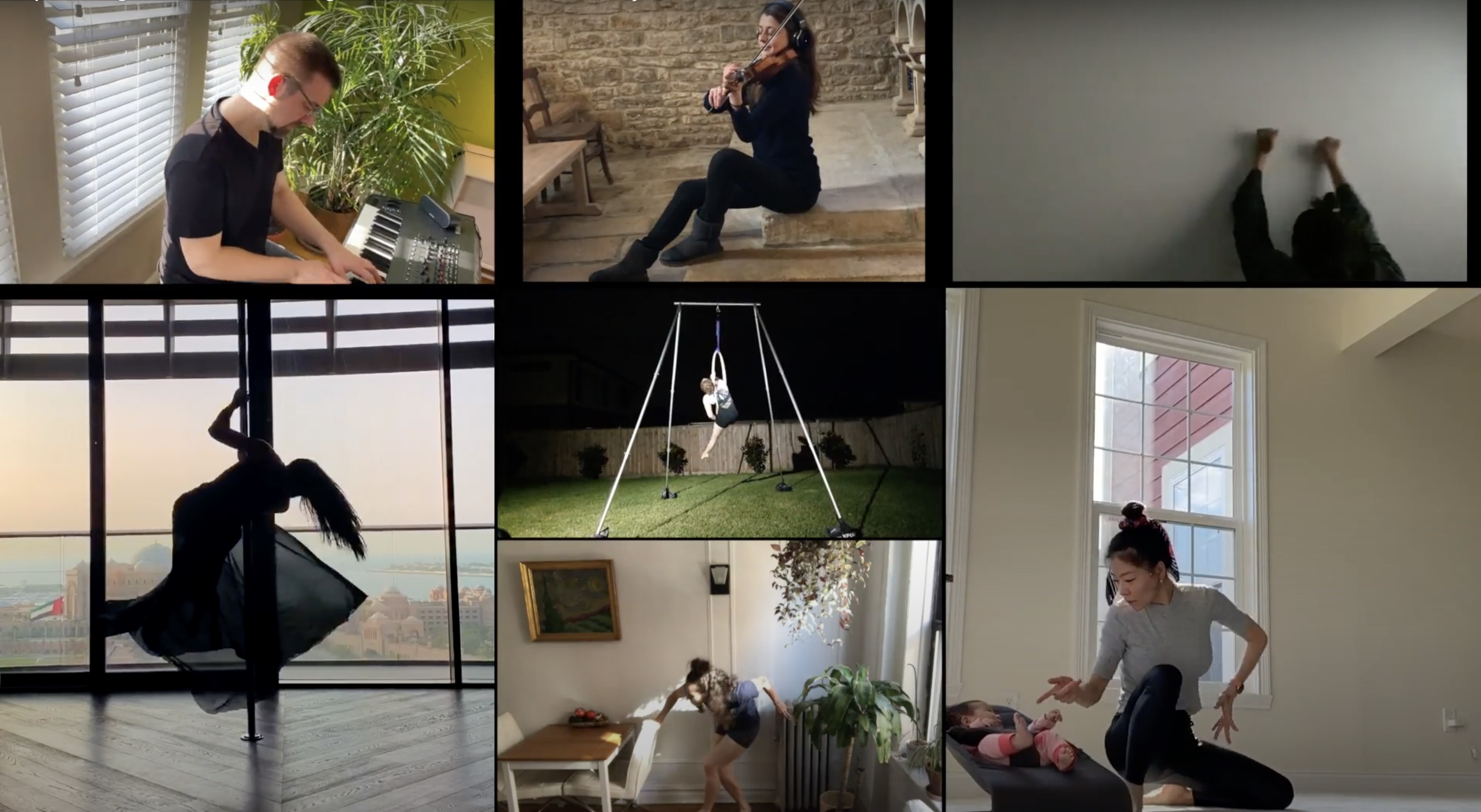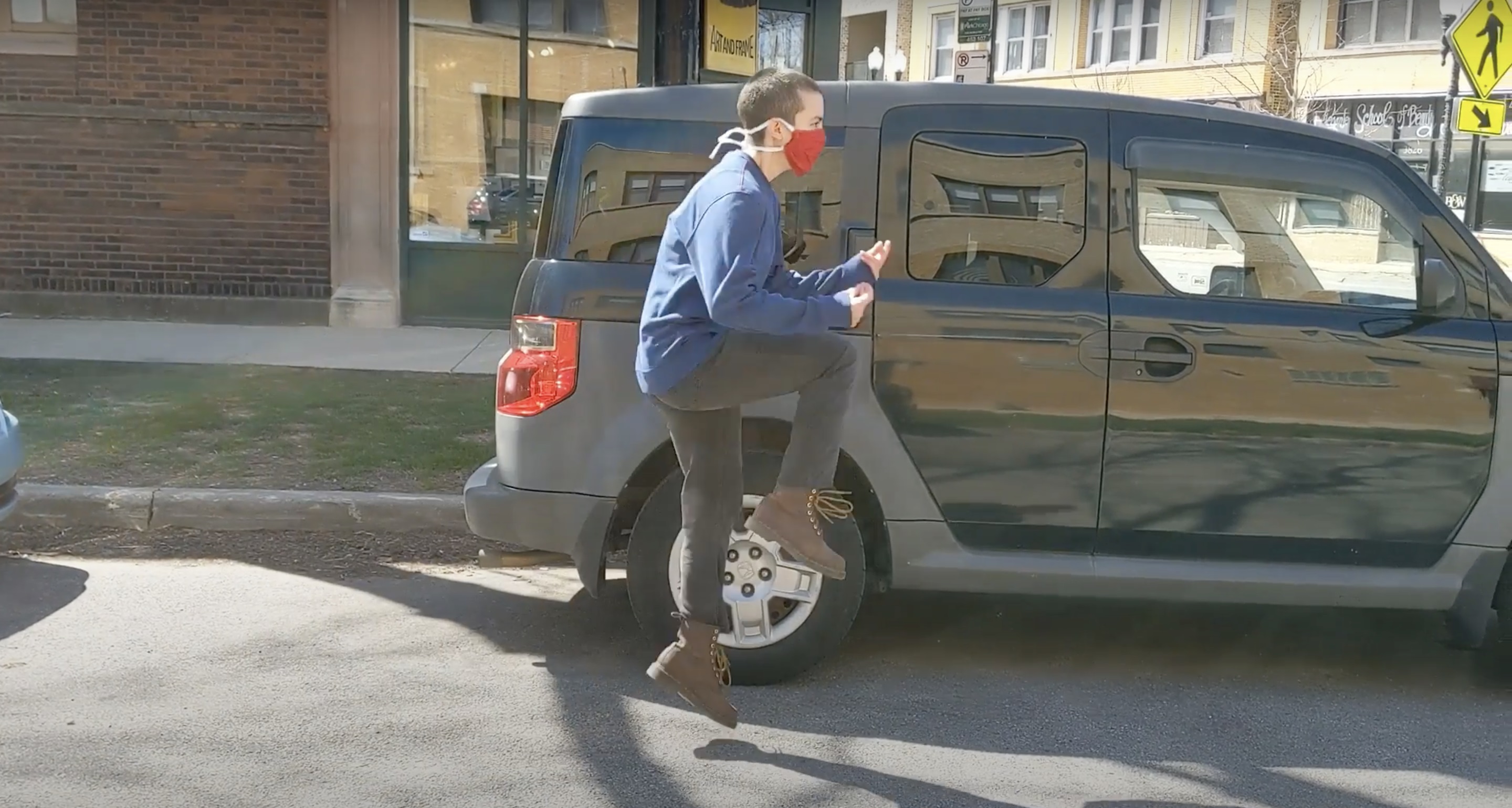Documenting Your Experience During Covid-19

Video collage of seven artists for project “apartTogether.” Image courtesy of the Chicago Dance History Project, from the Dancing Under Quarantine Collection. Project series was created by Joel Styzens during the stress of quarantine. Short description given by Joel: “Project apartTogether was created by 8 artists, strangers seeking creative and emotional connection during unprecedented isolation. Our story reveals that bonds built virtually can be significant and sustaining, encouraging stability and inspiration. / We invite you to enjoy our diverse geographic artistry that shares a united vision of hope. Please share our work as we continue to express that closeness is not always about proximity, and that we can be together even when we are apart.” Performers include Joel Styzens, Consuelo Lepauw, Queen, Xin Ying, Rachelle Scott, Erke Roosen, Hannah Brooke
The Covid-19 pandemic has caused immense hardship for many in the dance field. It has been a time of loss, grief, and anxiety, as well as resilience, creativity, and connection. In the future, there will be great value in having a record of this time, how people coped, how the dance field responded, and how the arts endured. This page offers suggestions for how you can document your experience, as well as information about national or regional efforts to collect archives of the Covid pandemic. Dance/USA would also love to hear from you about your archiving efforts during this time, and the Archiving & Preservation Department can offer guidance, answer questions, and support your process.
There are advantages to documenting the present while it is happening, especially in a rapidly-changing situation. You can capture details, reactions, and lived experience that you may not remember, or will remember differently, in the future. However, there is also value in retrospective stories, and in taking time and space to process. Do what feels right for you.
Things to keep in mind:
- ALL voices and stories are a crucial part of the record of this time. Archives often contain silences and gaps, perpetuating marginalization or erasure of certain individuals, groups, and histories. We can combat this by encouraging everyone to save and share their own stories and those of their communities.
- Not only triumphs are worth remembering. A complete and truthful record of this time will document achievements such as new streaming works or virtual galas, but also cancelations, closures, struggles, and the day-to-day experience of living and working under quarantine.
- Everyone copes differently with traumatic experiences. Some may find techniques like journaling, collecting, or recording conversations a beneficial means of processing this time; others will not. Do not feel obligated to do anything that makes you uncomfortable or adds to your stress. While the historical record is important, your wellbeing is more important. Be sensitive in asking others to document or share their experiences as well.
- You do not need to share your documentation of this time publicly right now, or ever.
While not focused on dance, this panel from the American Folk Art Museum and the Queens Memory Project, Virtual Insights: Documenting the Present, provides a wealth of ideas and tips for “archiving stories of resilience, hope, mutual aid, and loss” within organizations and communities. The webinar discusses ethical approaches to privacy, consent, mental health and safety in collecting or sharing archives of traumatic events.
Ways to document your experience
- Journaling: write regularly about your experiences, feelings, and observations, without worrying about the form or presentation.
- “Journaling, at a time like this, is also beneficial as a coping mechanism, offering us a private place to express our reactions in a way that we can revisit and reflect upon, so that we can better identify our needs and strengths. It also provides a sense of agency, as we transform ourselves from passive witnesses into active observers.” –Dr. Ananya Chakravarti, “Archiving the Present”
- Collecting: Save emails, texts, photos, posts, or screenshots that document your day-to-day experience during the pandemic. Curation is the process of deciding what you feel is relevant to your collection and will have lasting value. Cataloging is also important: jot down information about when/what/where: the date of the item, who created it, what it documents. You might want to create a simple spreadsheet inventory to track what you are saving.
- Remember that the writer of an email or social media post, or the person who took a photograph, is the copyright holder, so if you collect materials created by others, you do not have the rights to share them without permission.
- Documenting the Now, a community dedicated to the ethical collection, use, and preservation of social media, has tools and workshops supporting this mission.
- You can save webpages using Conifer/Webrecorder or the Internet Archive’s Save Page Now. Making PDFs or screenshots also works–just be sure you are backing up anything you want to save!
- Oral histories: One of the easiest, yet most meaningful, ways to document experience is by recording oral histories. This can be a formal, planned process, or as simple as recording a Zoom call, or using your phone to record a conversation with a friend or relative.

Kait Dessoffy dancing through the streets during quarantine. Video is part of the series “Dance Break” released by Synapse Arts. Image courtesy of the Chicago Dance History Project, from the Dancing Under Quarantine Collection. Caption from video reads, “Second Sidewalk / An adaptation of Rachel Damon’s “Crosswalk Dances” for Synapse Arts’ Dance Break 2020 / Music: “Play Song” by John Deley and the 41 Players / Choreography and Performance: Kait Dessoffy (some movement lovingly stolen from Michael Bennett & Bob Avian) / Cinematography: Mags Bouffard / Editing: Kait Dessoffy.”
Oral Histories
The Oral History Association offers a webinar “Oral History at a Distance: Conducting Remote Interviews,” which include advice on software platforms and how to achieve the best results when recording remote interviews.
Developing a plan and protocols before you get started can ensure a successful project:
- Check out the NYPL Dance Workers Covid oral history project for tips on how to conduct an interview using Zoom (or another video conferencing software), including suggested questions, scripts, and advice on getting a good quality recording.
- Decide on the scope of your project, and develop a list of questions, which can be adapted for individual subjects.
- Develop or adapt a form to get permission from interviewees to have their oral histories preserved and shared, and making a clear provision for who owns copyright. Use the templates below to get started.
- Think about whether you want to contribute to a community oral history project or partner with a library that will store and provide access to the interviews. If you want to keep the files to yourself for now–
- Create a plan for storing the files: remember it’s always best to have multiple copies stored in different places (for example, on a hard drive and in the cloud).
Copyright and Licensing Agreement
Web Guides to doing Oral Histories
These resources are drawn from the Society of American Archivists’ Documenting in Times of Crisis: A Resource Kit.
Crowdsourcing/Collecting Initiatives
Many institutions across the country have launched collecting, oral history, or other public memory initiatives to create archives documenting the experience of Covid. Here are some dance-specific projects, and extensive lists of other projects which you can search to find something in your region, or that has a relevant subject focus.
- Chicago Dance History Project: Dancing Under Quarantine
- NYPL Dance Workers Covid oral history project
- Documenting Your Community’s Experience of Covid-19, a nation-wide list of projects and resources from the Society of American Archivists
- Another list of initiatives to Document Covid-19 from Documenting the Now, including international projects
Tell us about your archives! Dance/USA would love to hear from you about where you are donating Covid-19 related materials, as well as any questions, concerns, or thoughts you’d like to discuss with the Archiving & Preservation Department. Use this form to tell us what you are doing to document this time, where you are submitting materials, and share any inquiries or insights about the process. Virtual consultations with the Archiving & Preservation Department are a free benefit for Dance/USA Members, and we would be happy to speak with you, answer any questions you may have, and be thought partners in your journey of documenting your experience.
